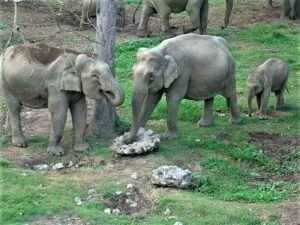
BY DR. RAVINDER PALL SAINI
( IFS, RETIRED)
MEMBER, BOARD OF MANAGEMENT
FOREST RESEARCH UNIVERSITY
DEHRADUN
DEHRADUN, 23 JANUARY 2023
The Indian elephant (Elephas maximus indicus) is one of three recognized subspecies of the Asian elephant and native to mainland Asia. Since 1986, Elephas maximus has been listed as Endangered by IUCN as the population has declined by at least 50% over the last 60 to 75 years or three generations. Asian elephants are threatened by habitat loss, degradation, and fragmentation.

Initial results from the first-ever synchronized All-India Elephant Population Estimation 2017 pegs India’s Asian elephant population at 27,312. The estimate, derived from the sighting-based direct count method alone, will be confirmed with estimates from the indirect dung-count method in three months.

Characteristics:
Asian elephants are smaller than African elephants and have the highest body point on the head. The tip of their trunk has one finger-like process. The back is convex or level.
Indian elephants reach a shoulder height of between 2 and 3.5 m (6.6 and 11.5 ft), weigh between 2,000 and 5,000 kg (4,400 and 11,000 lb), and have 19 pairs of ribs.

The skin colour is lighter than of maximus with smaller patches of depigmentation. Females are usually smaller than males and have short or no tusks. Indian elephants have smaller ears, but relatively broader skulls and larger trunks than
African elephants. Toes are large and broad. Unlike their African cousins, their abdomen is proportionate with their body weight, but the African elephant has a large abdomen as compared to the skulls.

Distribution and habitat:
The elephant populations are restricted to four general areas:
1.In the North – West — at the foot of the Himalayas in Uttarakhand and Uttar Pradesh, ranging from Katarniaghat Wildlife Sanctuary to the Yamuna River;

2.In the North – East – from the Eastern border of Nepal in Northern West Bengal through western Assam along the Himalaya foothills as far as the Mishmi Hills, extending into eastern Arunachal Pradesh, the plains of upper Assam, and the foothills of Nagaland, to the Garo Hills of Meghalaya through the Khasi Hills, to parts of the lower Brahmaputra plains and Karbi Plateau; isolated herds occur in Tripura, Mizoram, Manipur, and in the Barak Valley districts of Assam.
- In the central part — in Odisha, Jharkhand, and in the southern part of West Bengal, with some animals wandering into Chhattisgarh.
- In the South – eight populations are fragmented from each other in northern Karnataka, in the crest line of Karnataka–Western Ghats, in Bhadra–Malnad, in
Brahmagiri–Nilgiris–Eastern Ghats, in Nilambur–Silent Valley–Coimbatore, in Anamalai–Parambikulam, in Periyar–Srivilliputhur, and one in Agasthyamalai.

Ecology and behaviour:
Elephants are classified as mega herbivores and consume up to 150 kg (330 lb) of plant matter per day. They are generalist feeders, and both grazers and browsers. In a study area of 1,130 km2 (440 sq. mi) in southern India, elephants were recorded to feed on 112 different plant species, most commonly of the order Malvales, and the legume, palm, sedge, and true grass families. They graze on the tall grasses, but the portion consumed varies with season. When the new flush appears in April, they remove the tender blades in small clumps. Later, when grasses are higher than 0.5 m (1.6 ft), they uproot entire clumps, dust them skillfully and consume the fresh leave tops, but discard the roots. When grasses are mature in autumn, they clean and consume the succulent basal portions with the roots and discard the fibrous blades. From the bamboos, they eat seedlings, culms, and lateral shoots. During the dry season from January to April,they mainly browse on both leaves and twigs preferring the fresh foliage and consume thorn bearing shoots of acacia species without any obvious discomfort. They feed on the bark of white thorn and other flowering plants, and consume the fruits of wood apple, tamarind, kumbhi and date palm.

The movement and habitat utilization patterns of an elephant population were studied in southern India during 1981–83 within a 1,130 km2 (440 sq mi) study area. The vegetation types of this area encompass dry thorn forest at 250 to 400 m (820 to 1,310 ft), deciduous forest at 400 to 1,400 m (1,300 to 4,600 ft), stunted evergreen forest and grassland at 1,400 to 1,800 m (4,600 to 5,900 ft). Five different elephant clans, each consisting of between 50 and 200 individuals had home ranges of between 105 km2 (41 sq mi) and 320 km2 (120 sq mi), which overlapped. They preferred habitat where water was available and food plants were palatable. During the dry months of January to April, they congregated at high densities of up to five individuals per km2 in river valleys where browse plants had a much higher protein content than the coarse tall grasses on
hill slopes. With the onset of rains in May, they dispersed over a wider area at lower densities, largely into the tall grass forests, to feed on the fresh grasses, which then had a high protein value. During the second wet season from September to December, when the tall grasses became fibrous, they moved into lower elevation short grass open forests. The normal movement pattern could be upset during years of adverse environmental conditions.
Threats:
The pre-eminent threats to Asian elephants today are habitat loss, degradation, and fragmentation, which are driven by an expanding human population, and lead in turn to increasing conflicts between humans and elephants when elephants eat or trample crops. Loss of significant extents of elephant range and suitable habitat continues; their free movement is impeded by reservoirs, hydroelectric projects and associated canals, irrigation dams, numerous pockets of cultivation and plantations, highways, railway lines, mining and industrial development.
Poaching of elephants for ivory is a serious threat in some parts of Asia. Poaching of tuskers impacts on sex ratios that become highly female biased; genetic variation is reduced, and fecundity and recruitment may decline. Poaching has dramatically skewed adult sex ratios in the Periyar Tiger Reserve, where between 1969 and 1989 the adult male: female sex ratio changed from 1:6 to 1:122.

Elephant conservation in northern West Bengal has been set back due to high-levels of human–elephant conflict and elephant mortality owing to railway accidents. The railway track between Siliguri and Alipurduar passes through 74 km (46 mi) of various forestdivisions. Every day, scores of trains run on this track at high speeds. Elephants that pass through from one forest patch to another dash against the trains and die. A more than 100 elephants were reported killed during the period of 1958 to 2017.
Conservation:
Elephas maximus is listed on CITES Appendix I. Project Elephant was launched in 1992 by the Government of India Ministry of Environment and Forests to provide financial and technical support of wildlife management efforts by states for their free ranging populations of wild Asian Elephants. The project aims to ensure long-term survival of viable conservation reliant populations of elephants in their natural habitats by protecting the elephants, their habitats and migration corridors. Other goals of Project Elephant are supporting research of the ecology and management of elephants, creating conservation awareness among local people, providing improved veterinary care for captive elephants.

Advertisement:






























Add Comment